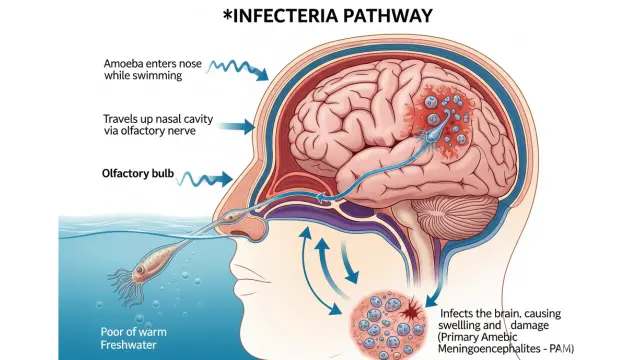Brain-Eating Amoeba Ozarks — it sounds scary, but it’s real and it’s here. A Missouri resident is in intensive care after contracting a rare and deadly infection believed to be linked to waterskiing on Lake of the Ozarks.
The culprit is Naegleria fowleri, also known as the “brain-eating amoeba.” Infections are super rare, but almost always fatal. Since 1962, there have been fewer than 170 cases in the US, but the mortality rate is over 95%.
This has everyone spooked, not just Missourians but also vacationers who visit the Ozarks every year. Now everyone is asking: How dangerous is this amoeba? Can it happen again? And how do you stay safe while enjoying summer water activities?
In this article, our HB Mag Health Research team gets the facts, explains what happened, and gives you practical safety tips every family should know.
What Happened at the Lake of the Ozarks?
Earlier this month, Missouri health officials confirmed a state resident is fighting a rare brain infection after visiting the Lake of the Ozarks. Investigators believe the person contracted the infection while waterskiing on the lake, where warm freshwater allowed the amoeba to thrive.
The patient is in intensive care, and lab tests confirmed the infection was caused by Naegleria fowleri. This microscopic organism is often called the “brain-eating amoeba” and enters the body when contaminated water goes up the nose and then to the brain.
This is not common. Missouri hasn’t had a confirmed case in nearly 40 years — the last one was in 1987. But the news has spooked locals, tourists, and businesses that rely on the Ozarks being a safe summer destination.
The Missouri Department of Health and Senior Services is working with the Centers for Disease Control and Prevention (CDC) to track the case and advise the public. So far no swimming bans, but they are urging visitors to take extra precautions when enjoying lake activities.
What Is the Brain-Eating Amoeba?
The “brain-eating amoeba” is not science fiction — it’s Naegleria fowleri, a microscopic organism found in warm freshwater. Lakes, rivers, hot springs, and even poorly maintained swimming pools can have this amoeba.
Despite the scary name, the amoeba doesn’t eat brains. Instead, the danger comes when water with Naegleria fowleri enters the nose. From there, the amoeba travels up the nasal passages to the brain and begins destroying brain tissue. This is a fast-moving and almost always fatal infection called primary amebic meningoencephalitis (PAM).

Here are the facts:
- 🦠 Naegleria fowleri lives in warm freshwater, especially during hot summer months.
- 🚫 You can’t get infected by drinking the water — only if it enters the nose.
- ⚠️ Infections are extremely rare — less than 10 in the US each year.
- 😔 The fatality rate is very high, and only a handful of survivors have ever been recorded.
Scientists say most people who swim in lakes or rivers will never be exposed to this amoeba. But because the consequences are so severe, even one case is a concern and reason for awareness.
Symptoms & Early Warning Signs
One of the scariest things about the brain-eating amoeba is how fast it can make you sick. The infection it causes, primary amebic meningoencephalitis (PAM), usually develops within 1 to 12 days after contaminated water gets in your nose.
At first, the symptoms can look like a regular summer bug, which is why you might miss it. But the disease progresses fast, and every hour counts.
⚠️ Early Symptoms (Day 1–3)
- Severe headache
- Fever
- Nausea or vomiting
- Stiff neck
🚨 Worsening Symptoms (After a few days)
- Confusion or difficulty concentrating
- Seizures
- Loss of balance
- Hallucinations
- Sudden changes in behavior
- Coma
Doctors say once symptoms appear, the infection moves fast. Without immediate treatment, the PAM is almost always fatal. That’s why if you develop severe headaches, fever, or neurological symptoms after swimming in warm freshwater, you should seek emergency medical care right away.
Even though cases are super rare, knowing these signs could be the difference between life and death.
Prevention & Safety Tips
The good news: while the brain-eating amoeba is deadly, infections are super rare. Millions of people swim in lakes and rivers every year without ever getting sick. Still, simple safety steps can lower your risk even more.
How to Stay Safe in Lakes and Rivers
- Keep water out of your nose. Use a nose clip or hold your nose shut when jumping or diving into freshwater.
- Don’t stir up sediment. The amoeba often lives in the soil at the bottom of lakes and rivers. Stay away from shallow, muddy areas where the water is warmest.
- Be extra cautious in hot weather. Naegleria fowleri loves warm water. Be more careful in late summer when the water is warmest.
Safe Water Practices at Home
- Don’t use tap water for nasal rinses. If you use a neti pot or sinus rinse, always use distilled, sterile, or previously boiled water.
- Keep pools and hot tubs clean. The amoeba can’t survive in properly chlorinated and disinfected water.
Tips for Families
- Remind kids not to let lake water go up their nose while swimming.
- Supervise water play, especially in shallow, warm areas.
📌 Bottom Line: Infection is rare, but taking a few precautions — especially keeping water out of your nose — is the way to go.
Treatment & Survival Chances
Once you’re infected with the brain-eating amoeba, time is of the essence. The disease it causes — primary amebic meningoencephalitis (PAM) — moves fast. Unfortunately, the survival rate is less than 5%, so most people don’t make it.
Current Treatment Options
Doctors use a mix of strong meds, often in the ICU:
- Amphotericin B – an antifungal drug that can kill the amoeba in your brain.
- Miltefosine – an experimental drug originally for cancer, now used in some PAM cases.
- Other antifungal and antibiotic meds – to slow the infection.
- Cooling your body (therapeutic hypothermia) – to reduce brain swelling.
Why Survival Is Rare
The biggest challenge is that PAM looks like other common illnesses at first, like meningitis or the flu. By the time doctors suspect Naegleria fowleri, the infection is already advanced. The amoeba destroys brain tissue fast, leaving little time to act.
Known Survivors
There have been only a handful of documented survivors worldwide. Most of them lived because:
- The infection was recognized very early.
- They got aggressive treatment with Miltefosine and antifungal meds.
- Brain swelling management was intense.
So, survival is possible — but only if diagnosis and treatment happen almost immediately.
Climate Change & Rising Risks
For years, the brain-eating amoeba was mostly found in southern U.S. states like Texas, Florida, and Louisiana. But in recent years, cases have been confirmed farther north — including Minnesota, Kansas, and now Missouri’s Lake of the Ozarks.
Experts say it’s because of climate change.
Warmer Waters, Wider Spread
- Naegleria fowleri loves warm freshwater. As summers get hotter and heat waves last longer, lakes and rivers stay warmer for longer.
- Warmer conditions allow the amoeba to survive in places where it used to be too cold.
- This means that states that never had to worry about the amoeba before could start seeing cases.
Rising Risk Patterns
- Studies show the geographic range of PAM cases is shifting northward.
- Infections are extremely rare — but each case raises concern because it highlights changing environmental risks.
- Experts say that as freshwater environments warm up, opportunities for human exposure increase, especially during recreational activities.
Why This Matters for the Ozarks
The Lake of the Ozarks is one of the busiest lakes in the U.S. With thousands of people swimming, boating, and waterskiing every summer, even a rare risk can have a big impact on public perception and safety planning.
History of Cases in the U.S.
The brain-eating amoeba has been known to science for decades, but confirmed human infections are very rare in the United States.
National Case Numbers
- Since 1962, the CDC has recorded around 160–170 cases of primary amebic meningoencephalitis (PAM).
- On average, the U.S. reports fewer than 10 cases per year.
- Sadly, the survival rate is very low; only a handful of people have survived.
Where Have Cases Happened?
- Southern states like Florida, Texas, and Louisiana have historically had the most cases.
- In the last 10 years, cases have shown up farther north, in Minnesota, Kansas, and now Missouri.
- This northward spread is what experts have been warning about with climate and water temperature changes.
Missouri’s Record
- The last known Missouri case was in 1987 — almost 40 years ago.
- The 2025 Lake of the Ozarks case is the first in decades, so it’s a rare but scary reminder that PAM is not limited to the southern U.S. anymore.
📌 Our Perspective: While the total number of cases is very small compared to the millions who swim in lakes every year, it’s the deadliness of the infection that makes each case so bad.
FAQs About the Brain-Eating Amoeba
Can you get the amoeba from drinking lake water?
No. Naegleria fowleri infection only happens when contaminated water enters the nose. Drinking the water does not cause PAM.
Is the Lake of the Ozarks safe to swim in?
Yes, the lake is still open for recreation. Infections are extremely rare. However, officials recommend taking precautions like using nose clips and avoiding stirring up sediment in shallow warm water.
Can chlorine kill the brain-eating amoeba?
Yes. Properly chlorinated swimming pools and hot tubs are considered safe because chlorine kills Naegleria fowleri. The risk is only in untreated or poorly maintained freshwater.
What are the first signs of infection?
Early symptoms usually start with severe headache, fever, nausea, and a stiff neck within 1–12 days of exposure. These progress quickly to confusion, seizures, and coma.
How common is PAM in the U.S.?
Very rare. Fewer than 10 cases per year are reported nationwide. Since 1962, only about 167 cases have been confirmed in the U.S.
Is there a cure for the brain-eating amoeba?
There is no guaranteed cure. Treatments like Amphotericin B and Miltefosine have been used, but survival remains extremely rare. Early diagnosis is the only chance for recovery.
Who is most at risk?
Anyone swimming in warm freshwater can be exposed, but children and young adults are more often reported in cases, likely because they spend more time playing and diving in lakes and rivers.
We’re a small team of health writers, researchers, and wellness reviewers behind Healthy Beginnings Magazine. We spend our days digging into supplements, fact-checking claims, and testing what actually works—so you don’t have to. Our goal is simple: give you clear, honest, and useful information to help you make better health choices without all the hype.



Recent Posts